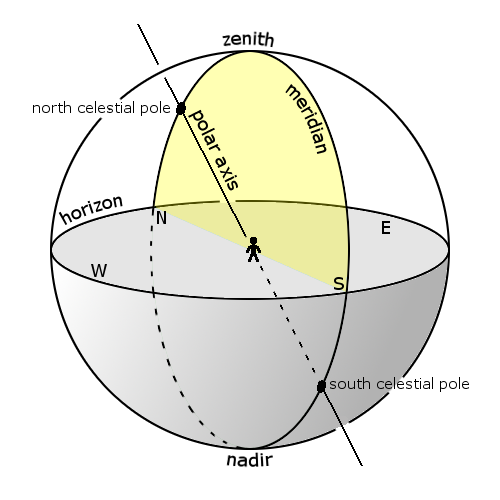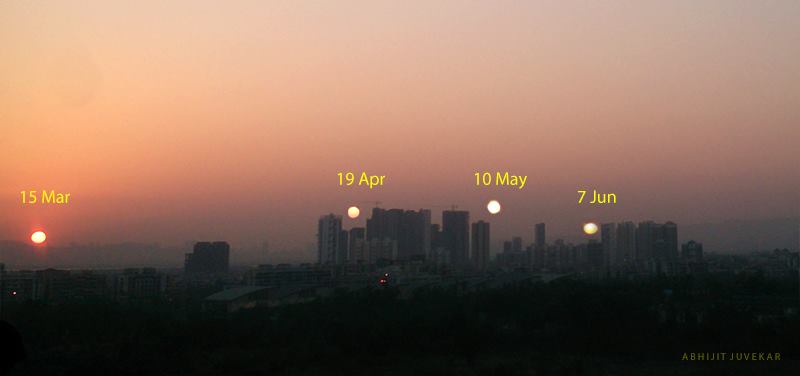Where Does the Sun Remain Above the Horizon All Day
At 40 degrees north it. A calculator able to show when the sun is at a given point would be a great addition.

Sun Crosses Your Meridian At Noon Astronomy Essentials Earthsky
What is the length of day at the equator.

. Only at the equator Everywhere between the Arctic Circle latitude 665N and the North Pole. But at the North Pole 90 degrees Polaris shines at zenith directly overhead. Now Im not so sure.
From the latter part of October through the latter part of February the Sun stays above the horizon line giving each day 24 hours of sunlight. We review their content and use your feedback to keep the quality high. It is highest in the sky at the Summer Solstice after which it moves closer to the horizon until it sinks below the horizon at the Fall Equinox.
So on the summer solstice the Sun is 47 235 705 degrees above due south at mean noon in Portland and 665 235 90 degrees above due south at the Tropic of Cancer. The Earths axial tilt of approximately 235 ensures that observers at different locations will see the Sun reach higher-or-lower positions above the horizon throughout the year. The sun appears to rise on the eastern horizon and sets on the western horizon.
So from the North Pole every star in the sky stays above the horizon all. How much does the location of the sun rising and setting change throughout the year and depending upon where your viewpoint is ie true East true West etc. Starry Night Software The sun crosses the equator travelling northward around March 21 and.
When the animation advances both the Sun and Virgo move from their position low on the eastern horizon to a higher point due south at noon note that the animation is a bit deceiving the stars and the Sun should appear to move at the same rate. Who are the experts. The longest and shortest daylight hours of the year.
Not all stars have heliacal risings because some stars remain above the horizon all the time. The sun would remain on the horizon circling around your observatory all day every day. Multiple choices aEverywhere between the Antarctic Circle latitude 665S and the South Pole bOnly at the equator cOnly at the South Pole.
Where does the Sun remain above the horizon all day never setting on the December solstice. Because these helical risings were so specific just one day they were used by many different ancient civilizations to mark specific events such as the drought season. On the summer solstice the Sun is 235 degrees north of the Celestial Equator.
There is an excellent in my understanding calculator that helps to calculate sun azimuth for each point on the globe and its angle to the horizon at a given time. In this first animation we see the Sun low on the eastern horizon at sunrise around 7am and it is in Virgo. On the winter solstice the Sun is 235 degrees south of the Celestial Equator.
A small development of the article Azimuth and solar elevation angle. Its all because of the tilt of the earths axis which if it were absent would alter your observations. The arctic and antarctic regions are almost always coldeven in the summer when they get 24 hours of sunlight a daybecause the suns angle above the horizon is never very high.
Inspired by the calculator request 3004. It is always exactly 12 hours. I recently told a friend with great certainty that at the equator the sun rose and set at exactly 12 hour intervals at roughly 6 am.
Circumpolar stars stay above the horizon all hours of the day every day of the year. Irrespective of where you are on the globe the Sun will always rise exactly East and set exactly West on two days. Where does the Sun remain above the horizon all day never setting on the December solstice.
Solstice The dates when the Sun reaches its highest or lowest point in the sky at noon marked by. And the tropics are almost always warmeven though they never get much more than 12 hours of sunlight in a daybecause the mid-day sun is always so high in the sky. DOnly on the Antarctic Circle latitude 665S eOnly at the North Pole fEverywhere between the Arctic Circle latitude.
Although you cant see them theyre up even in daytime. During the spring and summer equinoxes at noon the Sun will be the same angle above the horizon as your latitude. -For the Antarctic Circle latitude 665S the Sun remains above the horizon all day long only right around the time of the December solstice.
Everywhere between the Antarctic Circle latitude 665S and the South Pole. In summertime the sun is always above the horizon at the North Pole circling the Pole once every day. Experts are tested by Chegg as specialists in their subject area.
Only certain stars rise and flash into existence in the predawn glow of the horizon. Only on the Antarctic Circle latitude 665S Only at the North Pole Only at the South Pole. Multiple choices aEverywhere between the Antarctic Circle latitude 665S and the South Pole bOnly at the equator cOnly at the South Pole.
The Sun pauses in the winter sky marking the shortest day and longest night of the year. DOnly on the Antarctic Circle latitude 665S eOnly at the North Pole fEverywhere between the Arctic Circle latitude 665N and the North. Depending on the time zone every day of the year.
Where does the Sun remain above the horizon all day never setting on the December solstice. The dates when the Sun crosses Earths equator and the lengths of day and night are equal. During December solstice the su.
Where does the Sun remain above the horizon all day never setting on the December solstice.

Sun Stars Paths Griffith Observatory Southern California S Gateway To The Cosmos

Earthsky Equinox Fun Track Sun S Shift Between Now And Solstice
Comments
Post a Comment